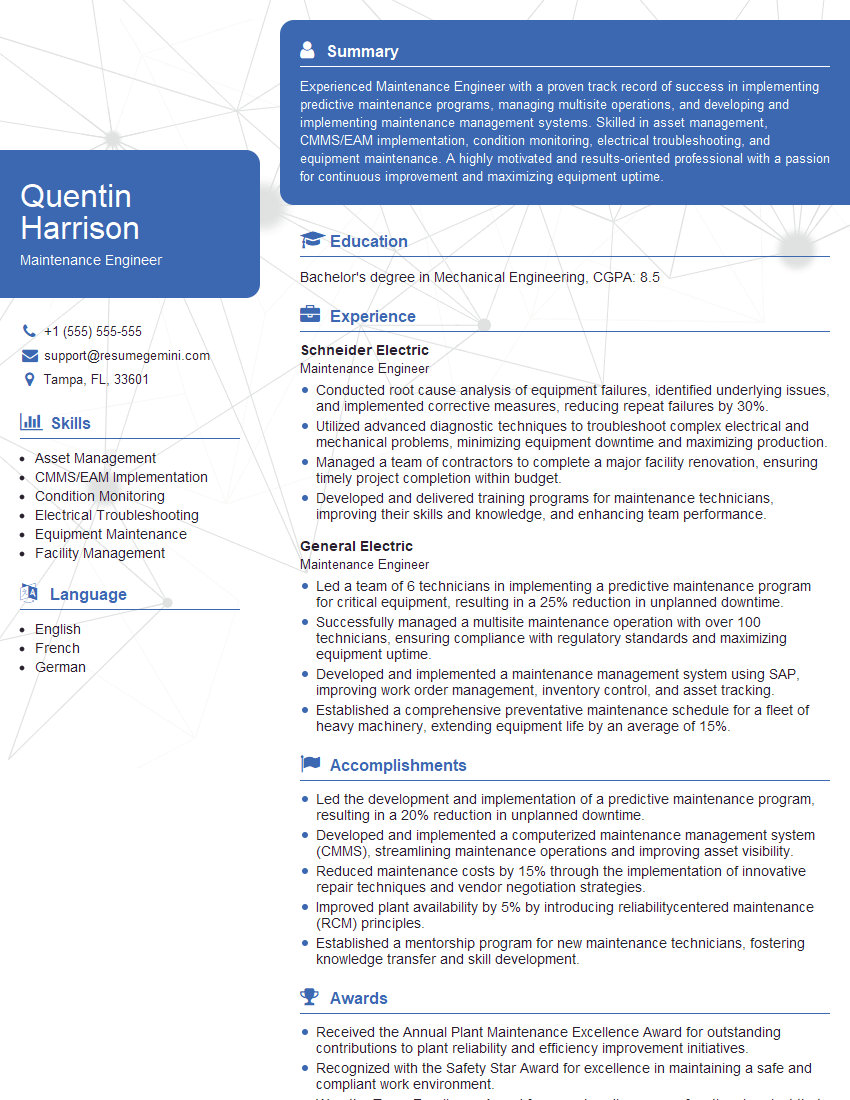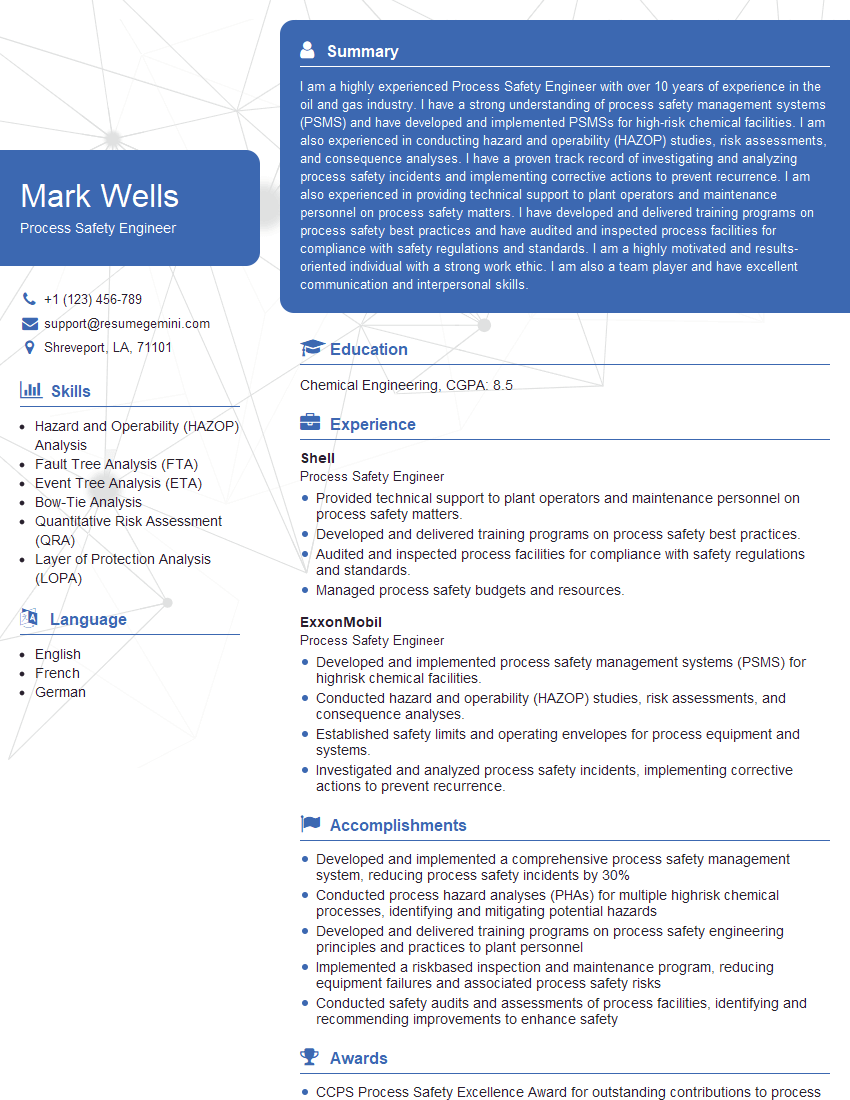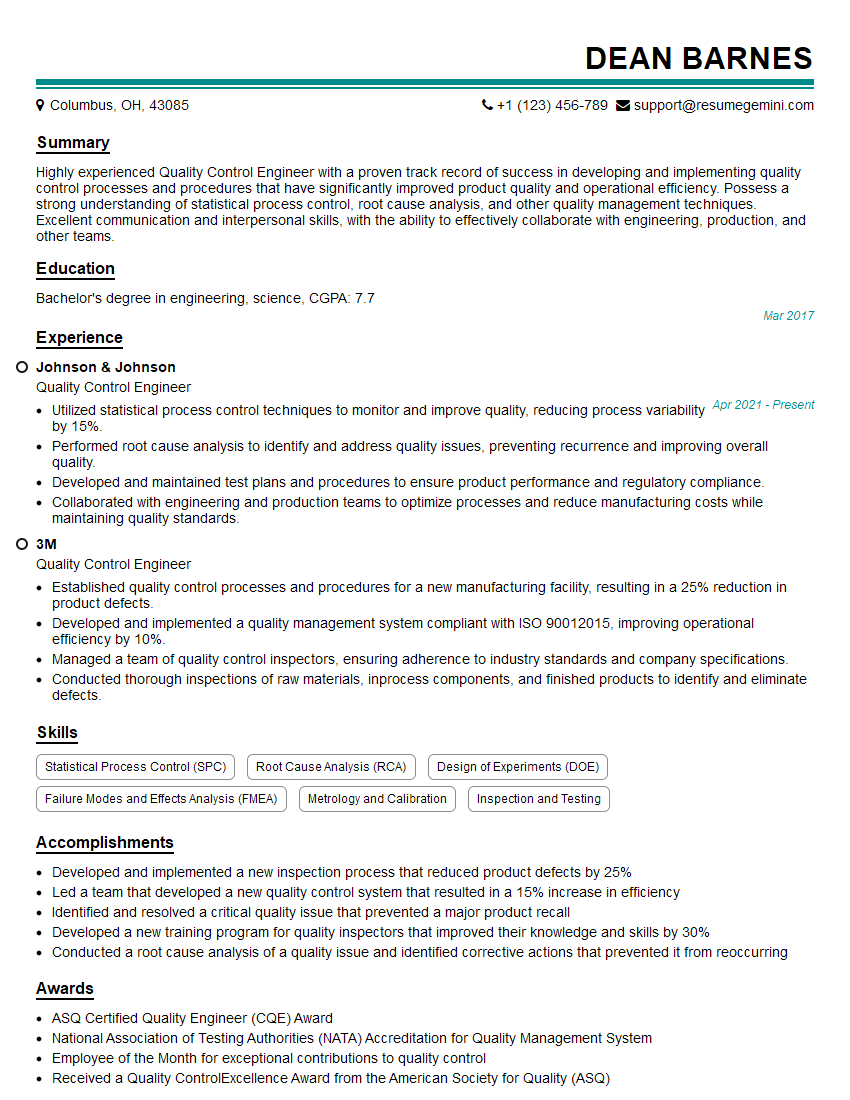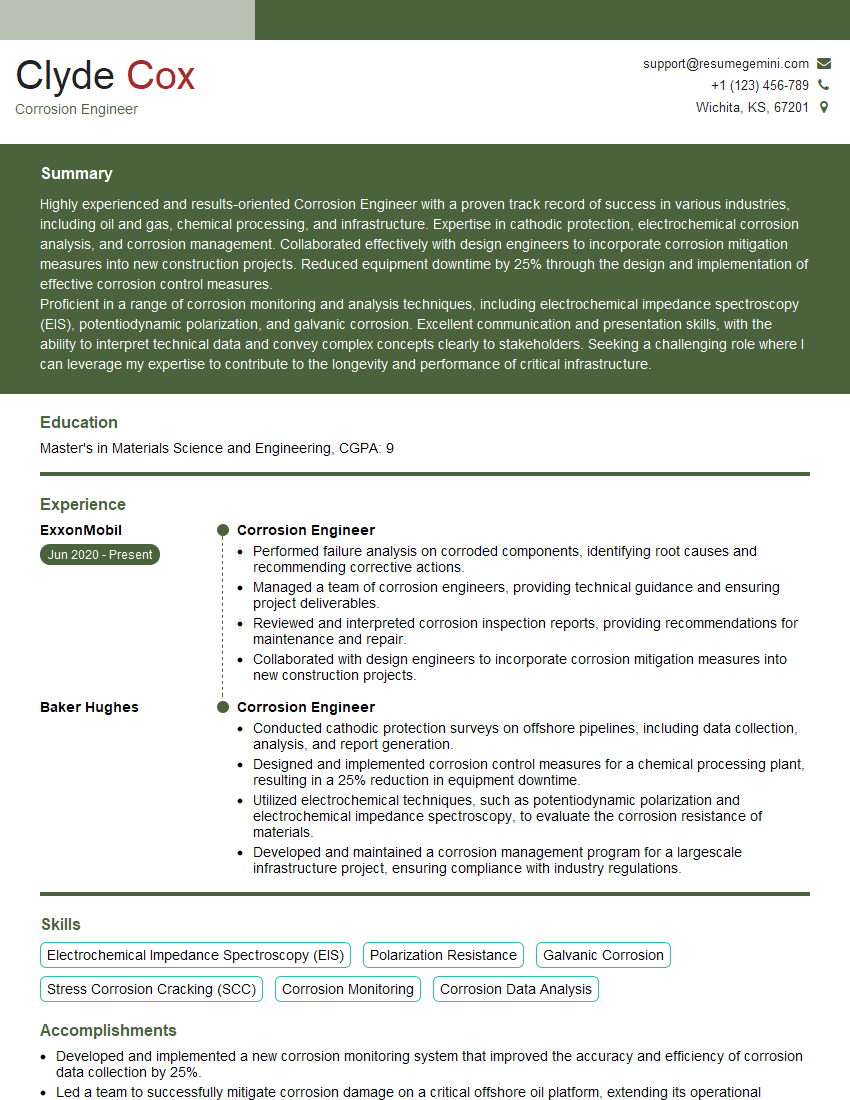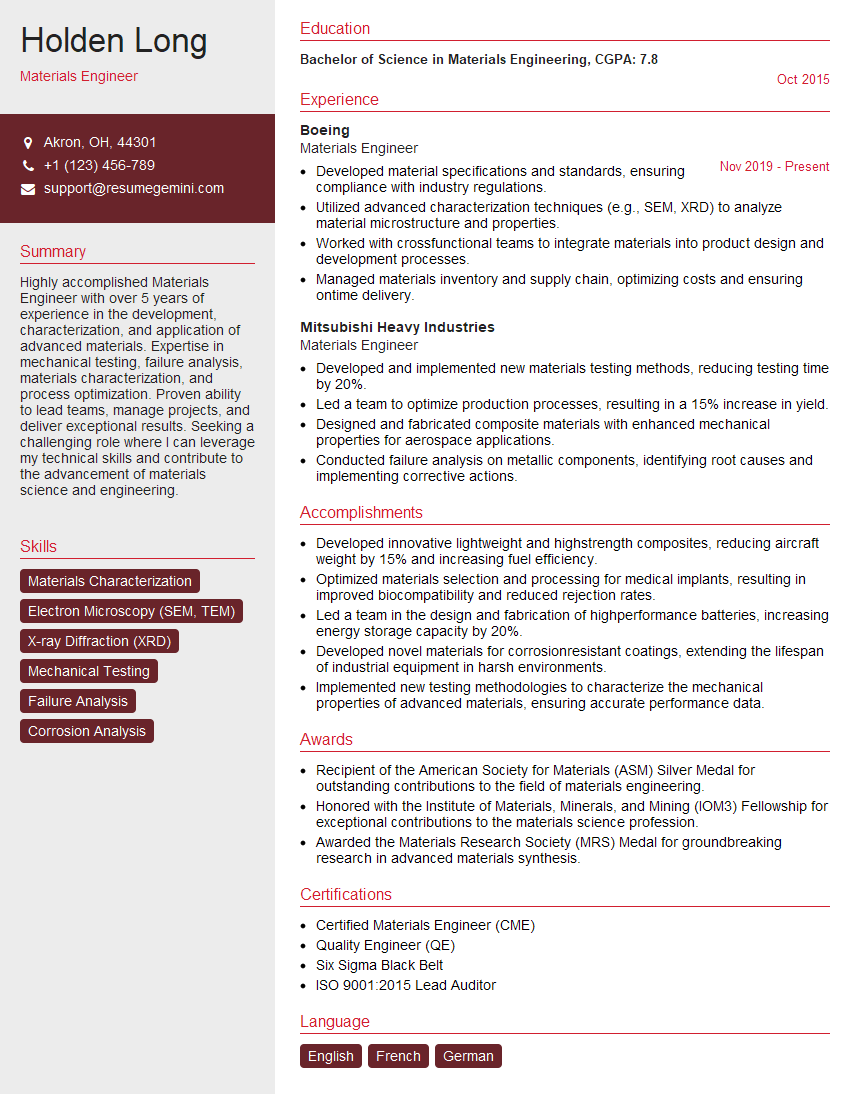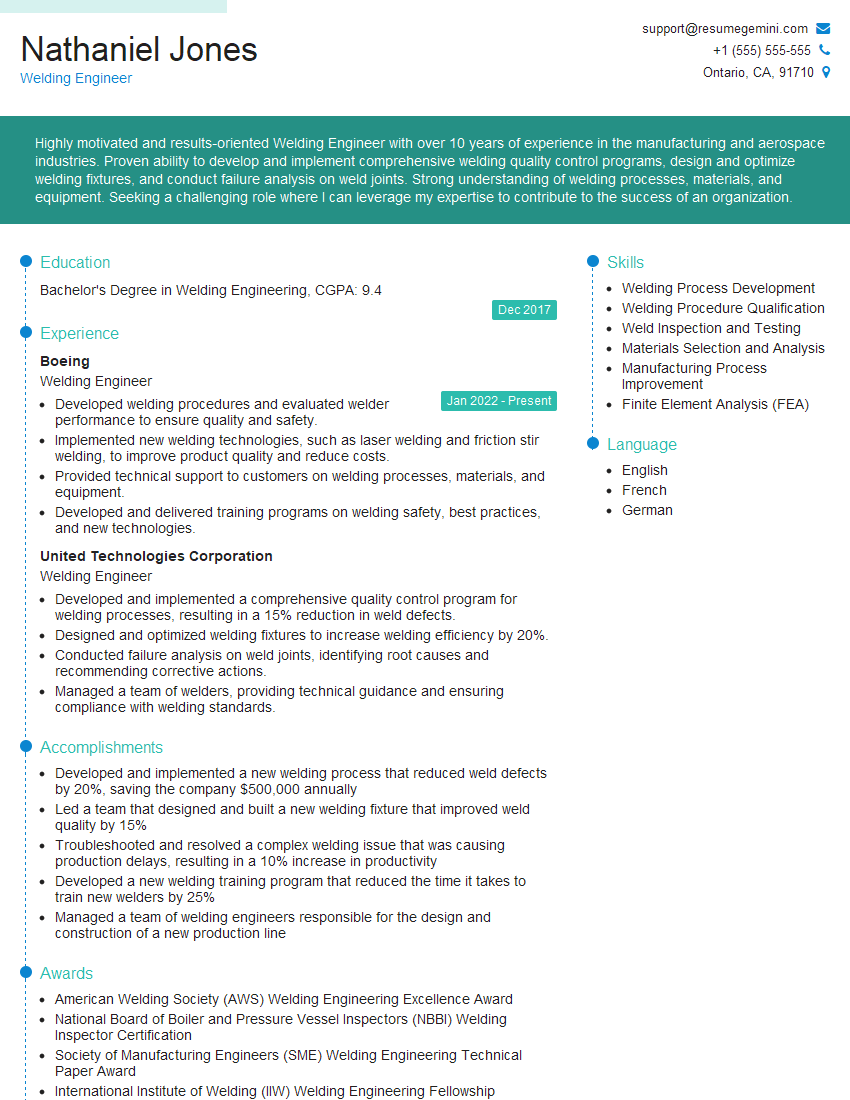Interviews are more than just a Q&A session—they’re a chance to prove your worth. This blog dives into essential Fitness-for-Service Assessment interview questions and expert tips to help you align your answers with what hiring managers are looking for. Start preparing to shine!
Questions Asked in Fitness-for-Service Assessment Interview
Q 1. Explain the difference between Fitness-for-Service and Risk-Based Inspection.
Fitness-for-Service (FFS) and Risk-Based Inspection (RBI) are both used to assess the integrity of equipment, but they differ significantly in their approach. FFS focuses on determining if a component with a known flaw or damage is still fit for continued service. It’s a detailed, quantitative assessment. RBI, on the other hand, is a broader, more qualitative approach that prioritizes inspection and maintenance based on the risk of failure. It considers factors like the consequence of failure, probability of failure, and the inspection effectiveness. Think of it this way: RBI decides what needs inspecting, while FFS determines if something is safe to continue operating after a defect is found.
For example, RBI might identify a specific pressure vessel as requiring inspection due to its age and operating conditions. If an inspection reveals a crack, an FFS assessment would then be used to evaluate whether the crack is acceptable, requiring repair, or necessitates replacement. RBI is about prioritization; FFS is about detailed evaluation of a specific defect.
Q 2. Describe the process of conducting a Fitness-for-Service assessment according to API 579.
API 579 provides a structured process for conducting FFS assessments. It generally follows these steps:
- Problem Definition: Clearly identify the flaw, its location, size, and the component in question.
- Material Characterization: Determine the material properties of the component, considering factors like temperature, corrosion, and degradation.
- Stress Analysis: Analyze the stresses acting on the component, including operating pressure, temperature, and external loads.
- Defect Assessment: Use appropriate assessment methods (like fracture mechanics) to determine the criticality of the flaw. This step considers flaw size, geometry, and material properties, often using assessment methods outlined in API 579-1/ASME FFS-1.
- Remaining Life Assessment: Once the criticality is determined, an assessment of the remaining life of the component can be made, considering both the initial flaw and the potential for future flaw growth.
- Recommendation: Based on the assessment, the appropriate action is recommended: continued operation with monitoring, repair, replacement, or other mitigation strategies.
It’s crucial to understand that API 579 offers multiple assessment methods for different types of flaws and loading conditions. The selection of the appropriate method is a critical part of the process and depends on the specific details of the flaw and the component.
Q 3. What are the key factors considered in determining the remaining life of a pressure vessel?
Determining the remaining life of a pressure vessel is a complex process involving several key factors:
- Initial Material Properties: The original strength and ductility of the vessel material are fundamental. Degradation over time due to factors like aging, corrosion, and creep significantly impacts remaining life.
- Operating Conditions: Temperature, pressure, and cyclic loading significantly influence material degradation and crack growth rates. Higher temperatures and pressures accelerate degradation.
- Inspection History: Data from previous inspections, including flaw detection and sizing, provides valuable information about the rate of flaw growth and the overall condition of the vessel.
- Corrosion Rate: Internal and external corrosion can weaken the vessel’s walls. Measuring and projecting corrosion rates are crucial for assessing remaining life.
- Flaw Characteristics: The size, shape, type, and location of any identified flaws greatly impact their criticality. Deep, sharp cracks are more dangerous than shallow, rounded ones.
- Fracture Mechanics Analysis: This uses the principles of fracture mechanics to predict crack growth under different loading conditions, helping determine when a crack might reach a critical size leading to failure.
Often, a combination of deterministic and probabilistic methods is employed to assess remaining life. Deterministic methods offer a conservative estimation, while probabilistic methods incorporate uncertainty and provide a range of potential lifetimes.
Q 4. Explain the significance of material properties in Fitness-for-Service assessments.
Material properties are paramount in FFS assessments. They dictate how the component will behave under stress and in the presence of flaws. These properties, determined through material testing or from specifications, are used in various assessment methods to determine the criticality of flaws and predict remaining life. Key properties include:
- Yield Strength: The stress at which the material begins to deform plastically.
- Ultimate Tensile Strength: The maximum stress the material can withstand before failure.
- Fracture Toughness (KIC): A measure of a material’s resistance to crack propagation.
- Fatigue Strength: The material’s resistance to failure under cyclic loading.
- Creep Strength: Resistance to deformation under sustained high temperatures and stresses.
For instance, a pressure vessel made of a high-strength steel with high fracture toughness can tolerate a larger flaw than one made of a lower-strength material with lower fracture toughness. Incorrect or incomplete material property data can lead to erroneous and potentially unsafe conclusions.
Q 5. What are the different types of non-destructive examination (NDE) methods used in FFS assessments?
Various Non-Destructive Examination (NDE) methods are employed in FFS assessments to detect and characterize flaws. The choice of method depends on the component’s geometry, material, and the type of flaw anticipated. Common methods include:
- Radiographic Testing (RT): Uses X-rays or gamma rays to detect internal flaws.
- Ultrasonic Testing (UT): Employs high-frequency sound waves to locate and size flaws.
- Magnetic Particle Testing (MT): Detects surface and near-surface cracks in ferromagnetic materials.
- Liquid Penetrant Testing (PT): Detects surface-breaking flaws in a wide range of materials.
- Visual Inspection (VI): A basic but essential method for detecting visible flaws and assessing the overall condition of the component.
The results of NDE are critical inputs for the quantitative assessment of the flaw. Accurate and thorough NDE is essential to ensure the safety and reliability of the FFS assessment.
Q 6. How do you interpret and apply fracture mechanics principles in an FFS assessment?
Fracture mechanics principles are fundamental to FFS assessments, especially when dealing with cracks. They provide a quantitative framework to predict crack growth and determine the critical flaw size at which failure is likely to occur. Key concepts include:
- Stress Intensity Factor (K): A parameter that characterizes the stress field around a crack tip. It is a function of crack size, geometry, and applied stress.
- Fracture Toughness (KIC): A material property representing the critical stress intensity factor at which rapid crack propagation occurs.
- Crack Growth Rate (da/dN): The rate at which a crack grows under cyclic loading, usually expressed as a function of the stress intensity factor range (ΔK).
In an FFS assessment, we use these principles to determine if a crack is stable (unlikely to grow significantly) or unstable (likely to grow and lead to failure). We also use them to predict the remaining life of a component with a crack, considering the anticipated loading conditions and the crack growth rate. For instance, a crack with a stress intensity factor significantly below the material’s fracture toughness is considered stable. However, if the stress intensity factor is approaching the fracture toughness, it warrants immediate attention, potentially leading to repairs or component replacement.
Q 7. Describe your experience with different FFS assessment software.
Throughout my career, I’ve had extensive experience with several FFS assessment software packages. This includes [Software Name 1], known for its comprehensive library of assessment methods and user-friendly interface. I’ve also worked extensively with [Software Name 2], which excels in its capabilities for complex geometry modeling and finite element analysis. My experience with [Software Name 3] has proven invaluable for its robust reporting features and compliance with various industry standards. The choice of software often depends on the complexity of the assessment, available data, and specific industry standards required. The software isn’t just about calculations; it’s about integrating all the necessary data, performing calculations according to standards and codes, and generating clear and concise reports.
Beyond the technical capabilities, my experience also emphasizes the importance of proper data input, validation, and interpretation of results. Software is only a tool, and the expertise of the engineer remains critical in guiding the assessment process and ensuring the validity and reliability of the conclusions.
Q 8. What are the limitations of Fitness-for-Service assessments?
Fitness-for-Service (FFS) assessments, while powerful tools, have limitations. One key limitation is the reliance on models and assumptions. The assessment’s accuracy depends heavily on the quality of input data and the validity of the chosen models, which may not perfectly represent real-world conditions. For example, a fatigue crack growth model might not perfectly capture the effects of complex loading scenarios or material degradation.
Another limitation is the inherent uncertainty associated with predicting future behavior. FFS assessments predict remaining life or acceptable operating conditions based on current observations. However, unforeseen events, such as unexpected increases in loading or aggressive environmental conditions, can render the assessment invalid. Think of predicting the lifespan of a bridge – the model is based on anticipated traffic and weather; an earthquake, however, is an unpredictable variable that can drastically affect the assessment’s validity.
Finally, the assessment’s cost and time requirements can be substantial, especially for complex structures or components with significant damage. The need for specialized expertise and advanced analytical techniques often translates to increased costs and project timelines.
Q 9. How do you handle uncertainties and data gaps in an FFS assessment?
Handling uncertainties and data gaps in an FFS assessment is a crucial aspect of the process. We employ a structured approach that combines conservative assumptions, sensitivity analyses, and probabilistic methods. When data is missing, we may leverage engineering judgment, historical data from similar components, or relevant industry standards to fill the gaps. Conservative estimates are preferred to avoid underestimating potential risks. For instance, if the corrosion rate is unknown, we would use the highest plausible rate based on relevant experience and industry standards.
Sensitivity analyses are performed to assess how the assessment results vary with changes in uncertain parameters. This helps identify the most influential parameters and prioritize data acquisition efforts. A simple example would be seeing how changes in crack size or material strength affect the remaining life calculation. Probabilistic methods, such as Monte Carlo simulations, can be used to incorporate uncertainty directly into the assessment, providing a more comprehensive view of the risk.
Furthermore, robust documentation of all assumptions and uncertainties is vital. Transparency helps ensure accountability and allows for informed decision-making by stakeholders. This documentation should clearly highlight the limitations of the assessment and any potential consequences of relying on assumptions.
Q 10. Explain the concept of allowable stress and its role in FFS assessments.
Allowable stress is the maximum stress a component can sustain under specified conditions while maintaining fitness for service. It’s a crucial parameter in FFS assessments because it represents the boundary between acceptable and unacceptable levels of stress. This value is usually determined based on material properties, applicable codes and standards (like ASME Section VIII, Division 2), and the presence of damage. For example, a component with a crack might have a reduced allowable stress compared to an undamaged component made of the same material.
In FFS assessments, we compare the calculated stress in the component (considering damage) to the allowable stress. If the calculated stress exceeds the allowable stress, the component is deemed unfit for service and requires remediation or replacement. Conversely, if the calculated stress remains below the allowable stress, the component remains fit for service under the assessed conditions. The selection of the appropriate allowable stress is critical, as overly conservative values might lead to unnecessary repairs, while overly lenient values might compromise safety.
Q 11. How do you determine the appropriate assessment methods for different types of damage mechanisms (e.g., corrosion, fatigue)?
The choice of assessment methods depends significantly on the type of damage mechanism. For example, corrosion damage is typically assessed using methods that evaluate the extent of material loss and its impact on the component’s structural integrity. This might involve visual inspection, thickness measurements, and corrosion rate calculations. We might employ API 579-1/ASME VIII-2 methods for specific corrosion types.
In contrast, fatigue damage is assessed by evaluating crack initiation and growth. This often requires non-destructive testing (NDT) methods, such as ultrasonic testing or radiography, to detect and characterize cracks. Advanced fracture mechanics techniques are then applied to predict crack growth rates and remaining life. For fatigue, we might use methods specifically addressing crack growth, considering stress ranges and material properties.
Other damage mechanisms, like creep or brittle fracture, would necessitate different assessment methods. The selection process always begins with a thorough understanding of the operating conditions, material properties, and the specific nature of the damage. We must carefully consider the possible interaction of multiple damage mechanisms, for example, corrosion that can accelerate fatigue crack growth.
Q 12. Describe your experience with API 579-1/ASME VIII-2.
API 579-1/ASME VIII-2 is a cornerstone standard for FFS assessments of pressure vessels and piping. I have extensive experience applying these standards in various industrial settings. My experience encompasses all stages of the FFS process, from initial damage assessment and data gathering to the final fitness-for-service determination and report generation.
I’ve used these standards to assess components with various types of damage, including corrosion, fatigue cracks, and flaws. I’m proficient in using various assessment methods described in the standard, including methods for evaluating flaws in pressure vessels and piping, stress analysis for damaged components, and determining remaining life. In my work, I’ve ensured strict adherence to the standard’s procedures and methodologies to ensure the accuracy and reliability of the assessments.
A recent example involved a refinery piping system where significant corrosion was detected. Using API 579-1/ASME VIII-2, we were able to determine the remaining life and develop a repair strategy that minimized downtime and ensured continued safe operation. This saved the company significant costs associated with unnecessary replacement of the pipeline.
Q 13. What are the key regulatory requirements relevant to Fitness-for-Service assessments?
Regulatory requirements for FFS assessments vary depending on the industry, geographic location, and the type of equipment being assessed. However, some common threads exist. Often, relevant regulations are derived from nationally recognized codes and standards such as ASME, API, and ISO. These standards provide guidelines for performing FFS assessments and establishing acceptable levels of risk.
For example, in the oil and gas industry, regulations often emphasize safety and environmental protection. Regulatory bodies like OSHA (Occupational Safety and Health Administration) and EPA (Environmental Protection Agency) may have specific requirements related to the inspection, maintenance, and repair of pressure vessels and piping. These regulations often necessitate documented FFS assessments to demonstrate compliance and avoid safety hazards.
In other industries, similar regulations exist, tailored to the specific hazards associated with the equipment and processes involved. Compliance with these regulations is essential to ensure the safe and reliable operation of equipment, and non-compliance can result in significant penalties and legal consequences.
Q 14. How do you communicate complex technical information to non-technical audiences?
Communicating complex technical information to non-technical audiences requires a strategic approach. I avoid using jargon and technical terms whenever possible, replacing them with clear, simple language that everyone can understand. I use analogies and real-world examples to illustrate complex concepts, making them more relatable and easily grasped. For example, instead of explaining complex fracture mechanics, I might use the analogy of a cracked plate to illustrate the concept of stress concentration.
Visual aids such as diagrams, charts, and infographics are invaluable tools. They can simplify complex data and make it easier to understand. I also tailor my communication style to the audience’s level of understanding. A presentation to senior management might focus on the high-level risks and costs, whereas a presentation to technicians might involve more detailed explanations of the assessment methodologies. Finally, I always encourage questions and feedback to ensure that everyone understands the information presented and feels comfortable engaging in a discussion.
Q 15. Describe your experience with Fitness-for-Service assessments in specific industries (e.g., oil and gas, power generation).
My experience in Fitness-for-Service (FFS) assessments spans over 10 years, primarily within the oil and gas and power generation sectors. In the oil and gas industry, I’ve been involved in assessing the integrity of pipelines, pressure vessels, and offshore platforms, focusing on corrosion, fatigue, and cracking. This often involves evaluating the remaining life of critical components to ensure safe and continued operation. In power generation, my work has centered on assessing the condition of boilers, turbines, and piping systems, paying close attention to creep, high-temperature oxidation, and thermal fatigue. A recent project involved a detailed assessment of a cracked steam header in a coal-fired power plant, where we used advanced non-destructive examination techniques and finite element analysis to determine its remaining life and recommend appropriate repair strategies.
For example, in one project involving an offshore platform, we identified localized corrosion in a critical support structure. Through detailed inspection, metallurgical analysis, and FFS assessment, we were able to determine the acceptable level of damage and create a repair plan to maintain safe operational conditions. This saved the client significant costs by avoiding premature replacement of the structure.
Career Expert Tips:
- Ace those interviews! Prepare effectively by reviewing the Top 50 Most Common Interview Questions on ResumeGemini.
- Navigate your job search with confidence! Explore a wide range of Career Tips on ResumeGemini. Learn about common challenges and recommendations to overcome them.
- Craft the perfect resume! Master the Art of Resume Writing with ResumeGemini’s guide. Showcase your unique qualifications and achievements effectively.
- Don’t miss out on holiday savings! Build your dream resume with ResumeGemini’s ATS optimized templates.
Q 16. How do you ensure the accuracy and reliability of your FFS assessment results?
Ensuring the accuracy and reliability of FFS assessment results is paramount. This involves a multi-faceted approach that begins with meticulous planning and extends through to thorough documentation and verification.
- Comprehensive Data Collection: We employ a range of inspection techniques, including visual inspection, ultrasonic testing, radiography, and advanced non-destructive testing methods, to thoroughly assess the component’s condition. Data is meticulously documented, verified, and cross-referenced to reduce errors.
- Appropriate Assessment Codes and Standards: We adhere strictly to relevant industry codes and standards, such as ASME Section VIII, Division 1 and API 579-1/ASME FFS-1, ensuring the assessment methodology is consistent and aligned with best practices.
- Expert Review and Validation: Our assessments are subject to rigorous internal and, where required, external peer reviews. Independent experts verify the findings, methodology, and conclusions. This ensures objectivity and minimizes bias.
- Traceability and Documentation: A detailed audit trail is maintained throughout the assessment process. This enables easy tracing of data, methodologies, and conclusions, enhancing the transparency and reliability of the findings.
Regular calibration and verification of our equipment and procedures are also integral to the process. We conduct internal audits and participate in proficiency testing programs to maintain the highest levels of accuracy and precision.
Q 17. What is your experience with conducting root cause analyses related to equipment failures?
Root cause analysis is a crucial element of any comprehensive FFS assessment, particularly following an equipment failure. My experience involves applying various root cause analysis techniques, including the ‘5 Whys’ method, Fault Tree Analysis (FTA), and Fishbone diagrams. These methodologies aid in systematically identifying the underlying causes of failure, preventing recurrence.
For instance, in a recent investigation of a pipeline failure, we used FTA to identify a combination of factors including material degradation, operational stress, and inadequate inspection intervals. This helped us understand the failure mechanism and devise strategies to avoid similar events in the future. This could range from improving inspection protocols and implementing enhanced monitoring systems to modifying operational procedures or upgrading materials.
Q 18. Describe your familiarity with different failure modes and their associated assessment methods.
I’m familiar with a wide range of failure modes, including fatigue, corrosion, creep, brittle fracture, and stress corrosion cracking. Each failure mode demands a unique assessment methodology.
- Fatigue: Assessed using fracture mechanics principles, examining crack growth rates and stress levels.
- Corrosion: Evaluated via visual inspection, thickness measurements, and metallurgical analysis.
- Creep: Assessed by considering operating temperatures, stresses, and material properties over time.
- Brittle Fracture: Determined through fracture toughness testing and analysis of stress concentrations.
- Stress Corrosion Cracking: Assessed by analyzing the environmental conditions and material susceptibility to cracking.
The choice of assessment method depends on the specific failure mode, material, operating conditions, and available data. We frequently use finite element analysis (FEA) to simulate stress distribution and predict remaining life, enhancing the accuracy of our assessments.
Q 19. How do you incorporate risk management principles into your FFS assessments?
Risk management is intrinsically linked to FFS assessments. We integrate risk principles throughout the assessment process, considering the probability and consequences of potential failure scenarios.
- Risk Identification: We begin by identifying potential failure modes and their associated consequences. This involves reviewing operational history, past inspection reports, and relevant industry data.
- Risk Assessment: We then quantify the likelihood and severity of each identified risk. This often involves probabilistic approaches, such as using reliability data and Bayesian methods.
- Risk Mitigation: Based on the risk assessment, we recommend appropriate mitigation strategies. These could involve implementing enhanced monitoring, adjusting operational parameters, performing repairs, or replacing components.
- Risk Monitoring: The effectiveness of mitigation strategies is continually monitored through regular inspections and reassessments.
A crucial aspect is communicating risk effectively to stakeholders. We provide clear and concise reports that articulate the identified risks, our assessment methodology, and recommended actions. This ensures informed decision-making and helps prioritize risk mitigation efforts.
Q 20. What are the key differences between Level 1, Level 2, and Level 3 FFS assessments?
The three levels of FFS assessments (Level 1, Level 2, and Level 3) represent an increasing level of complexity and detail.
- Level 1: A screening assessment that uses simplified methods to quickly determine whether further investigation is necessary. It typically involves visual inspection and basic calculations to check if damage is within allowable limits.
- Level 2: A more detailed assessment that employs more sophisticated analytical techniques and requires more comprehensive data. This might include detailed non-destructive examination, finite element analysis, and advanced material characterization.
- Level 3: The most complex level, involving advanced analytical techniques, detailed material modeling, and potentially extensive experimental work. It’s usually reserved for situations involving significant damage or critical components where a high degree of certainty is required.
Think of it like medical diagnosis: Level 1 is a preliminary check-up, Level 2 is a more detailed examination with tests, and Level 3 is a specialist consultation for complex cases.
Q 21. Explain the concept of fitness-for-service criteria and how it’s determined.
Fitness-for-service criteria define the acceptable limits of damage or degradation for a component to continue operating safely. These criteria are derived from various sources including:
- Industry Codes and Standards: Organizations like ASME and API publish codes and standards that specify acceptable limits of damage for various types of equipment and materials.
- Engineering Assessments: Detailed engineering calculations, using fracture mechanics, finite element analysis, and other methods, can determine the acceptable level of flaws and remaining structural capacity.
- Risk Assessment: The risk associated with continued operation of the component with existing damage is considered, and acceptance criteria are set based on the acceptable level of risk.
- Operational Limits: Operating pressures, temperatures, and other parameters are considered to ensure the component remains within its operational envelope.
The determination of fitness-for-service criteria is a crucial step in the assessment process. The chosen criteria must balance safety and economic considerations. In some cases, additional margins of safety are added to account for uncertainties.
Q 22. How do you manage multiple concurrent FFS projects?
Managing multiple concurrent Fitness-for-Service (FFS) projects requires a structured approach. Think of it like conducting an orchestra – each project is an instrument, and I’m the conductor. Successful management hinges on meticulous planning, prioritization, and effective resource allocation.
- Project Prioritization: I utilize a matrix prioritizing projects based on factors such as risk, regulatory deadlines, and client urgency. This allows me to focus resources on the most critical assessments first.
- Resource Allocation: This involves assigning personnel with appropriate skills and experience to each project. Clear roles and responsibilities are defined to avoid overlaps and ensure efficient workflow. I also track resource utilization closely to anticipate and address potential bottlenecks.
- Project Tracking and Reporting: Regular progress meetings and detailed reports are essential. We use project management software to monitor deadlines, track progress, and identify potential issues proactively. This allows for timely intervention and keeps stakeholders informed.
- Communication: Maintaining transparent communication among project teams and stakeholders is vital. Regular updates prevent misunderstandings and ensure everyone is aligned on project goals and progress.
For instance, in one instance, I managed three concurrent FFS projects – one for a refinery, one for a petrochemical plant, and one for a power generation facility. By prioritizing tasks based on regulatory deadlines and utilizing a project management software, we successfully completed all three projects on time and within budget.
Q 23. What is your experience with report writing and documentation of FFS assessments?
Report writing is an integral part of FFS assessments; it’s the culmination of our work and the basis for critical decisions. My reports are concise, accurate, and easy to understand, even for non-technical audiences. I always follow a standardized structure to ensure consistency and completeness.
- Clear and Concise Language: I avoid technical jargon whenever possible, explaining complex concepts in simple terms. I use visuals like diagrams and charts to enhance understanding.
- Structured Approach: My reports follow a well-defined structure, including an executive summary, detailed findings, analysis, recommendations, and conclusions. Each section is clearly labeled and easy to navigate.
- Data Integrity: I rigorously verify all data used in the assessment and clearly trace its origin. Any assumptions or limitations are clearly stated. I use version control to track changes.
- Review and Approval Process: Before final submission, reports undergo a thorough internal review and approval process to ensure accuracy and quality. This process typically involves a peer review from another experienced engineer.
I’ve written numerous reports on diverse projects, ranging from pressure vessel assessments to pipeline integrity management. A key principle is to provide actionable recommendations – not just identify problems, but also propose practical solutions for the client. For example, I once prepared a report outlining the required repairs and subsequent inspection plan for a corroded pipeline that was concise, well-illustrated, and ultimately resulted in a faster and safer remediation strategy.
Q 24. How do you stay current with the latest advancements in Fitness-for-Service methodologies?
Staying current in the dynamic field of FFS requires continuous learning. I achieve this through a combination of professional development activities and networking:
- Professional Societies and Conferences: I am an active member of relevant professional societies such as ASME and actively attend industry conferences and workshops to learn about new methodologies, standards, and best practices. These events provide invaluable opportunities to network with other experts.
- Industry Publications and Journals: I regularly read industry publications and journals to keep abreast of the latest research, developments, and case studies. This keeps me informed of the latest advancements in material science, failure analysis, and risk assessment.
- Online Courses and Webinars: Online platforms offer various courses and webinars focusing on advanced FFS techniques and software applications. I actively participate in relevant online training to enhance my skills and knowledge.
- Collaboration and Mentorship: I actively engage in discussions with colleagues and peers and participate in mentorship programs. Sharing knowledge and experiences greatly expands my understanding of FFS techniques.
For example, I recently completed a course on advanced finite element analysis, allowing me to integrate this powerful technique into my FFS assessments, significantly improving the accuracy and reliability of my analyses.
Q 25. Describe a challenging FFS assessment you conducted and how you overcame the challenges.
One particularly challenging assessment involved a critical component in a nuclear power plant that exhibited unexpected degradation. The initial assessment using standard methods suggested a need for immediate replacement, which would have caused significant downtime and cost.
The challenge was to determine the root cause of the degradation and to accurately assess the remaining life of the component without resorting to an immediate, costly replacement. We overcame this challenge by:
- Detailed Material Characterization: We conducted advanced material characterization tests, including advanced microscopy and chemical analysis, to better understand the degradation mechanisms.
- Advanced Modelling Techniques: We used advanced fracture mechanics and finite element analysis (FEA) to simulate the component’s behavior under operating conditions and predict its remaining life accurately.
- Collaboration with Experts: We collaborated with materials scientists and nuclear engineers with specialized expertise to ensure the accuracy of our analyses and interpret the data correctly.
- Risk-Based Approach: We used a risk-based approach to evaluate the consequences of potential failure and carefully weigh the risks associated with continued operation against the cost of replacement.
Ultimately, our analysis demonstrated that, with some carefully monitored operational changes and a revised inspection schedule, the component could remain in service for a significantly longer period than initially thought. This saved the client millions of dollars in replacement costs and avoided a considerable production downtime. This experience highlighted the importance of employing advanced techniques and a comprehensive approach in challenging FFS assessments.
Q 26. How do you ensure the quality and integrity of your FFS assessments?
Ensuring the quality and integrity of FFS assessments is paramount. It requires a multi-faceted approach based on established quality management principles.
- Adherence to Standards and Codes: All our assessments are conducted in accordance with relevant industry standards and codes, such as ASME Section VIII, API 579-1/ASME FFS-1, and other applicable regulations. This ensures consistency and rigor.
- Peer Review and Quality Checks: Each assessment undergoes a thorough peer review by another experienced engineer to identify any potential errors or omissions. This independent review serves as a critical quality check.
- Traceability and Documentation: All data, analyses, and conclusions are meticulously documented and traceable. This allows for verification and auditing of our work. Using a robust document management system is crucial.
- Calibration and Verification of Equipment: Any equipment used in the assessment is regularly calibrated and verified to ensure its accuracy and reliability. This is particularly important for non-destructive examination (NDE) methods.
- Continuous Improvement: We actively seek feedback from clients and incorporate lessons learned from past assessments to continually improve our processes and methodologies. Regular internal audits help to identify and address weaknesses.
We treat quality assurance as an ongoing process, not just a final step. This commitment ensures that our clients receive high-quality, reliable assessments they can trust.
Q 27. What are some common errors to avoid during an FFS assessment?
Several common errors can compromise the integrity of an FFS assessment. Avoiding these is vital for obtaining reliable results. Think of it like building a house – a faulty foundation compromises the entire structure.
- Incomplete Data: Insufficient or inaccurate data can lead to flawed conclusions. Thorough data collection is crucial.
- Inappropriate Assumptions: Making unsupported assumptions can significantly affect the assessment outcome. Assumptions need to be clearly stated and justified.
- Oversimplification of Complex Issues: Oversimplifying complex failure mechanisms can lead to an inaccurate assessment. The assessment needs to reflect the real-world complexity.
- Ignoring Uncertainties: Uncertainty in data and analysis should be explicitly addressed. Probabilistic approaches are often necessary.
- Neglecting Human Factors: Human error can significantly impact equipment reliability. Human factors should be considered in the assessment.
- Lack of Documentation: Poor or incomplete documentation can render the assessment unreliable and difficult to review or audit.
Careful planning, methodical execution, and rigorous review processes help minimize these errors and produce credible, reliable results.
Q 28. Explain your understanding of the relationship between Fitness-for-Service and maintenance planning.
Fitness-for-Service (FFS) and maintenance planning are closely intertwined. FFS assessments inform maintenance strategies, while maintenance activities affect the ongoing fitness of equipment. Think of them as two sides of the same coin.
FFS assessments determine the remaining life and structural integrity of equipment. This information is critical for developing effective maintenance plans. For instance:
- Prioritization of Maintenance Tasks: FFS assessments identify critical components requiring immediate attention, helping prioritize maintenance tasks and optimize resource allocation.
- Justification for Repairs or Replacements: FFS provides a technical basis for justifying the need for repairs or replacements, facilitating better decision-making regarding maintenance investments.
- Development of Inspection Plans: The assessment results directly influence the development of effective inspection plans, ensuring that critical components are monitored appropriately.
- Extension of Equipment Life: By identifying areas of concern and recommending appropriate remedial actions, FFS assessments contribute to extending the operational life of equipment, reducing the frequency of replacements.
- Risk Mitigation: The assessment process helps to identify potential failure mechanisms and their associated risks, leading to proactive risk mitigation strategies in the maintenance plan.
In essence, FFS provides the technical foundation for informed and cost-effective maintenance planning, helping organizations maximize the operational life of their assets while ensuring safety and reliability.
Key Topics to Learn for Fitness-for-Service Assessment Interview
- Fundamentals of Fitness-for-Service (FFS): Understanding the core principles, objectives, and scope of FFS assessments.
- Failure Mechanisms and Degradation Processes: Analyzing potential failure modes in components and systems, including fatigue, corrosion, and creep. Practical application: Identifying critical areas requiring assessment based on operational history and material properties.
- Material Properties and Selection: Understanding the impact of material properties on component lifespan and how to select appropriate materials for specific applications. Practical application: Justifying material choices based on FFS criteria and relevant codes.
- Assessment Methods and Techniques: Familiarizing yourself with various non-destructive examination (NDE) methods and their applications in FFS assessments (e.g., ultrasonic testing, radiography). Practical application: Evaluating the effectiveness and limitations of different NDE techniques for specific scenarios.
- Risk Assessment and Management: Understanding how to quantify and manage risks associated with continued operation of components. Practical application: Developing a risk-based inspection plan based on identified failure mechanisms and consequences.
- Codes and Standards: Familiarity with relevant industry codes and standards governing FFS assessments (e.g., ASME Section VIII, API 579). Practical application: Applying code requirements to specific case studies and justifying assessment decisions based on code interpretations.
- Data Analysis and Reporting: Interpreting inspection data, analyzing assessment results, and preparing comprehensive reports. Practical application: Presenting findings clearly and concisely, making recommendations for repairs or replacements.
- Economic Considerations: Balancing the cost of FFS assessment with the potential costs of failure. Practical application: Justifying the economic feasibility of different assessment and repair options.
Next Steps
Mastering Fitness-for-Service Assessment significantly enhances your career prospects in the engineering and inspection fields, opening doors to advanced roles and higher earning potential. A strong, ATS-friendly resume is crucial to showcasing your skills effectively. To build a compelling resume that highlights your FFS expertise and increases your chances of landing your dream job, we strongly recommend leveraging ResumeGemini. ResumeGemini offers a user-friendly platform and provides examples of resumes tailored to Fitness-for-Service Assessment roles, allowing you to craft a professional document that makes a lasting impression on potential employers.
Explore more articles
Users Rating of Our Blogs
Share Your Experience
We value your feedback! Please rate our content and share your thoughts (optional).
What Readers Say About Our Blog
Hi, I have something for you and recorded a quick Loom video to show the kind of value I can bring to you.
Even if we don’t work together, I’m confident you’ll take away something valuable and learn a few new ideas.
Here’s the link: https://bit.ly/loom-video-daniel
Would love your thoughts after watching!
– Daniel
This was kind of a unique content I found around the specialized skills. Very helpful questions and good detailed answers.
Very Helpful blog, thank you Interviewgemini team.

